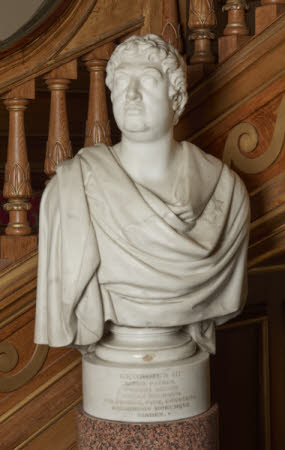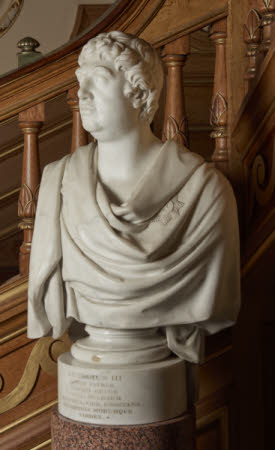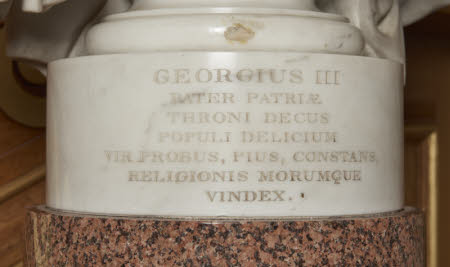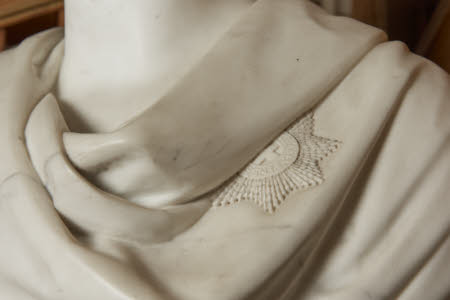George III
Sir Richard Westmacott II, RA (London 1775 - London 1856)
Category
Art / Sculpture
Date
circa 1838
Materials
Marble on turned marble socle and plinth
Measurements
1010 x 550 x 300 mm
Place of origin
London
Order this imageCollection
Belton House, Lincolnshire
NT 436759
Summary
Carrara white marble on turned marble socle and inscribed plinth, George III (1738–1820), Sir Richard Westmacott (1747-1808), c. 1838, signed ‘Westmacott R.A.’ on truncation, rear, proper right. George III is shown in middle age in the antique manner, head turned to the right and looking outward. He wears a cloak draped across the shoulders with the badge of the Order of the Garter pinned to proper left breast. The hair is curly and styled with a band in the Roman manner. The bust stands on a turned marble socle and a cylindrical marble plinth inscribed ‘GEORGIUS III | PATER PATRIÆ | THRONI DECUS | POPULI DELICIUM | VIR PROBUS, PIUS, CONSTANS, | RELIGIONIS MORUMQUE | VINDEX.’
Full description
The bust is related to the figure of George III in equestrian statues Westmacott completed for Liverpool and Windsor (1818-22 and 1824-31 respectively). The king is deliberately dressed in Roman robes because Westmacott wished to ‘avoid [the] literalness of modern costume’, though the Garter Star identifies him as a British sovereign (Westmacott quoted in Busco 1994, pp.66-7). Westmacott enjoyed much patronage from John Cust (1779–1853, later 1st Earl Brownlow), having secured Antonio Canova to produce a memorial of his first wife, Lady Sophia Brownlow, who died in 1814. Sophia was the daughter of Sir Abraham Hume (1749-1838), a noted collector and patron of the arts who commissioned Westmacott to produce a portrait bust displayed in Wormley Church. In 1838, when the Hume Collection was inherited by the Brownlows of Belton, the account for that year shows payment to Westmacott for the sum of £220 for an undated bust of George III and its plinth. Alice Rylance-Watson October 2018
Provenance
Purchased 1838 by John Cust, 1st Earl Brownlow (1779–1853), probably from the estate of Sir Abraham Hume (1749-1838); purchased with a grant from the National Heritage Memorial Fund (NHMF) from Edward John Peregrine Cust, 7th Baron Brownlow, C. St J. (b.1936) in 1984.
Credit line
Belton House, The Brownlow Collection (acquired with the help of the National Heritage Memorial Fund by the National Trust in 1994)
Marks and inscriptions
Truncation, back, proper right: Westmacott R.A. Plinth, front : GEORGIUS III | PATER PATRIÆ | THRONI DECUS | POPULI DELICIUM | VIR PROBUS, PIUS, CONSTANS, | RELIGIONIS MORUMQUE | VINDEX.
Makers and roles
Sir Richard Westmacott II, RA (London 1775 - London 1856), sculptor
References
Busco 1994 Marie Busco Sir Richard Westmacott Sculptor. Cambridge Studies in the History of Art, Cambridge University Press, 1994, pp.66-7





